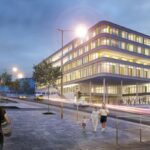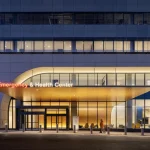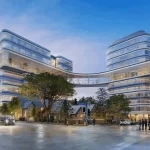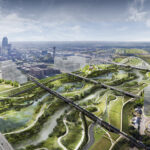Hospital of the University of Pennsylvania Pavilion, Foster + Partners American Healthcare Building News
Hospital of the University of Pennsylvania Pavilion Building
November 9, 2021
The Pavilion at the Hospital of the University of Pennsylvania opens
Design: Foster + Partners, Architects
Location: 1 Convention Ave, Philadelphia, PA 19104, United States of America
The Pavilion Hospital of the University of Pennsylvania
The University of Pennsylvania has announced the opening of The Pavilion, a state-of-the-art inpatient facility designed by the PennFIRST integrated project delivery team (IPD) with Foster + Partners, HDR, engineers BR+A, and LF Driscoll, Balfour Beatty and Penn Medicine. The Pavilion will serve as a new institutional and architectural icon for Penn Medicine on its extensive academic medical campus in West Philadelphia. Co-located with some of the world’s most advanced research laboratories and specialized treatment facilities, the building enables collaboration and research centered on patient focused care, serving as a blueprint for the ‘hospital of the future’.
Norman Foster, Founder and Executive Chairman, Foster + Partners, said: “The new Pavilion at the Hospital of the University of Pennsylvania is designed to completely redefine the future of healthcare. The building enables innovations that reflect University of Pennsylvania’s history of medical firsts, creating a truly flexible facility that molds itself to the needs of the patient. Responsive, adaptable and future-proof, it will allow the hospital to continue its crucial life-saving work and remain at the cutting edge of patient care.”
Kevin Mahoney, CEO of the University of Pennsylvania Health System added: “It’s a thrilling time to be part of Penn and our broader Philadelphia community, and we are truly honored to be part of such a dramatic and positive change, as we celebrate the opening of the Pavilion. This new building now stands as a testament to Penn’s mission to serving humanity — from West Philadelphia to the East Coast, and beyond. The team who designed, built, and now cares for patients in the Pavilion has shown us what the future of medicine looks like and ensured that Penn will be the epicenter of the very best care for generations to come.”
Nigel Dancey, Senior Executive Partner, Foster + Partners, added: “From the beginning, the integrated delivery team set out to challenge the existing model of healthcare delivery to create a new paradigm for hospitals in the future. Working collaboratively, we developed innovative ways to research and completely rethink patient care with the wellbeing of staff and patients along with long-term flexibility at the heart of our approach. The result is evident – an incredible facility for innovation, research and patient care that will set the benchmark for the future.”
In addition to being a world-class medical facility, the Pavilion serves as a bridge across a bustling, urban academic medical campus. Continuing Philadelphia’s wonderful civic tradition, the design creates a new public square, a focus for the surrounding buildings, anchoring the Pavilion and creating new connections between the hospital and university campus. The form of the building, and color and articulation of the façade, reference the historic Penn campus and are in keeping with the architecture of the campus – the building’s curve references the rotunda of the adjacent University of Pennsylvania Museum. Gardens planted around the public spaces are visible and accessible to visitors. A new landscaped pedestrian path, Discovery Walk, provides a direct connection with the public transport system.
Chris West, Partner, Foster + Partners, said: “The Pavilion knits the medical campus with the overall university through its materiality and urban planning. Its form is singular and sculptural, creating a recognizable new marker on the skyline of the Penn campus. At ground level, spaces flow from the street into the building, creating an inviting experience for pedestrians and providing a welcome contrast to the dense development of hospital buildings that surround the area.”
The design of the building is sustainable, efficient, uplifting and sensitive to its surroundings, responding to the needs of people – material and spiritual, measurable and intangible. From curbside to bedside, the Pavilion is designed with the human experience in mind. The main arrival spaces are bright, warm and welcoming, with daylight and views that orient the user. Throughout the ground level, there are engaging works of art such as, a signature sculpture by Maya Lin and a major mural by Odili Donald Odita. By prioritizing light and views for the patients, visitors and staff, the design embraces a holistic view towards the wellbeing of the people inside.
Circulation areas are indirectly lit for patient comfort, while also creating a sense of respite, rhythm and wayfinding for visitors and staff as they navigate the building. Patient rooms and treatment areas are user-centered, offering controls that allow for individual comfort and customization. Patient movement is minimized, allowing treatments to be delivered directly in the patient room whenever possible.
The uncertainties experienced throughout the COVID-19 pandemic have emphasized the need to design a hospital that can adapt with rapidly changing science, medicine, and patient care. The Pavilion’s patient care floors were designed with a unique, flexible planning system that enables the 72-bed floors to be broken down into smaller unit sizes that respond to changing needs and patient demands. The 504 inpatient rooms are conversion-ready, with space and infrastructure capable of handling any level of acuity from medical-surgical to intensive care.
An interactive footwall integrates entertainment, room controls, communications, and medical record information to better engage patients and families with clinicians and keep them informed throughout their stay. Recognizing that families are an important part of the care team, ample space is allocated for visitors to spend time and stay the night in support of their loved ones. Floors are laid out in an “on-stage/off-stage” model that minimizes disruptions to patients and allows ample space for clinical teams to collaborate, research and provide the best patient care. In an effort to provide care for caregivers, the Pavilion boasts numerous staff respite spaces, featuring sweeping exterior views, daylit interventional suites, flexible and comfortable furnishings, and other amenities that ensure the wellbeing of Penn Medicine’s incredible clinical staff.
Through the extensive use of prefabricated components, construction was carried out on a very constrained site. This expansion of multi trade prefabrication was a first for Philadelphia and was one of many community engagement elements that benefited the West Philadelphia neighborhood. The IPD team also hired a warehouse and setup a prefabrication facility that combined disparate disciplines together.
This meant that the electrical subcontractor worked directly with the sheet metal fabricators and the plumbers work together with the IT and AV groups, encouraging collaboration and facilitating communication. There were a number of large-scale items fabricated in this warehouse – both as prototypes and finished versions for installation –including multi-trade racks and prefabricated bathrooms. Working in the framework of the IPD, it quickly became clear that the advantages of designing this way were substantial and could be extended, with a little effort, to the construction process as well – resulting in a higher-quality building.
Hospital of the University of Pennsylvania Pavilion images / information received 081121 from Foster + Partners Architects
Phone: +1 800-789-7366
Location: 1 Convention Ave, Philadelphia, Pennsylvania, United States of America
Pennsylvania Buildings
Contemporary Architecture in Pennsylvania – architectural selection below:
Lower Hill District Master Plan, Pittsburgh
Design: BIG
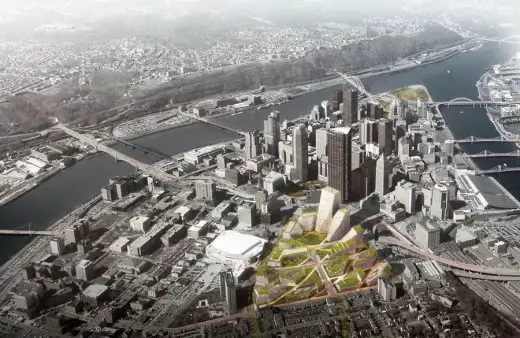
image from architecture office
Lower Hill District Master Plan Pittsburgh
Rauch College of Business
Design: Voith and Mactavish Architects
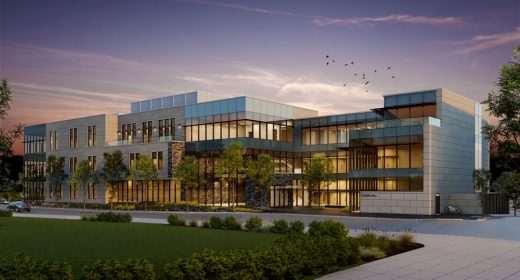
image courtesy of architects practice
Rauch College of Business, Lehigh University
Frick Environmental Center
Design: Bohlin Cywinski Jackson architects
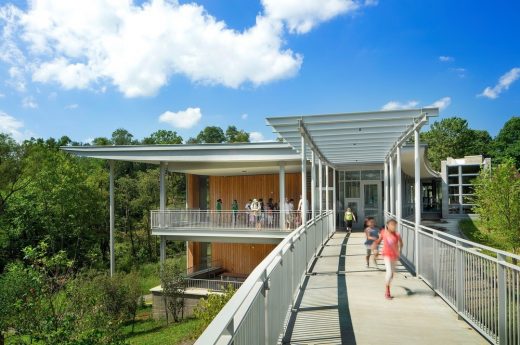
image Courtesy architecture office
Frick Environmental Center Building
Philadelphia Buildings
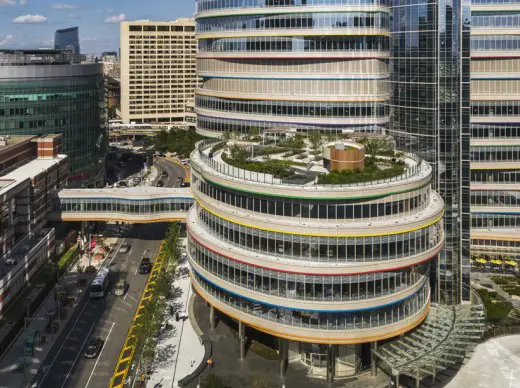
photograph : Jeff Goldberg, Esto
Pittsburgh Architecture
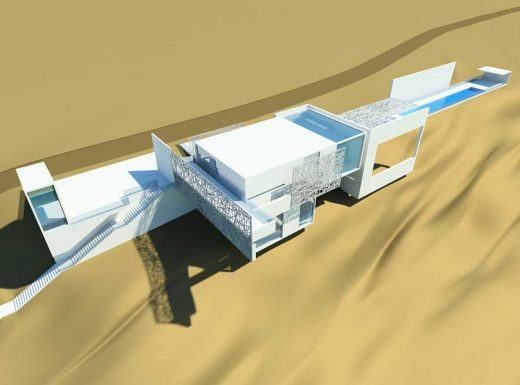
picture from architect
US Architecture
US Architecture Design – chronological list
Comments / photos for the Hospital of the University of Pennsylvania Pavilion design by Foster + Partners Architects page welcome

